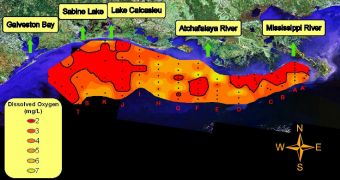Investigations conducted in the Gulf of Mexico have revealed that the dead zone which developed there this year is the fifth largest on record. The formation covers an area about the same size as the state of New Jersey.
Scientists with the US National Oceanic and Atmospheric Administration (NOAA) conducted a recent series of measurements, and determined that the affected region covers about 7,722 square miles.
This spread reaches the upper limit of predictions made for 2010. One of the things that differed from estimates is the fact that the dead zone is not a single area, but rather a series of patches spread our throughout the Gulf.
NOAA experts say that these smaller zones were produced when a lager one was subjected to intense tropical storm activity that struck the region recently. They say that, regardless of this event, the total area covered by dead zones is twice as large than the one recorded in 2009.
Last year, only 3,000 square miles were designated as oceanic dead zones. In order for an area to merit this classification, it needs to have very low oxygen levels that do not support the existence of too many complex species of marine animals.
“Large algal blooms seen in surface waters to the west of the river were not unusual considering the prediction of size for 2010 and the continued input of fresh water and nutrients from the [Mississippi] river,” says Nancy Rabalais, PhD.
“It may be difficult to link conditions seen this summer with oil from the BP spill,” adds the experts, who is the director of the Louisiana Universities Marine Consortium. The research she conducted covered an area spanning between the Mississippi River delta and the Galveston Bay.
“Despite fluctuations in the size of the dead zone due to short-term weather events, the fact remains that we have a large and persistent area of severely degraded habitat that is caused by excessive nutrient pollution draining into the Gulf,” says Robert Magnien, PhD.
He is the director of the NOAA Center for Sponsored Coastal Ocean Research. “Additional threats to the Gulf’s economically important living resources, such as the recent oil spill, only increase the urgency to implement nutrient reduction efforts that will help to restore critically needed habitat,” he concludes.

 14 DAY TRIAL //
14 DAY TRIAL //